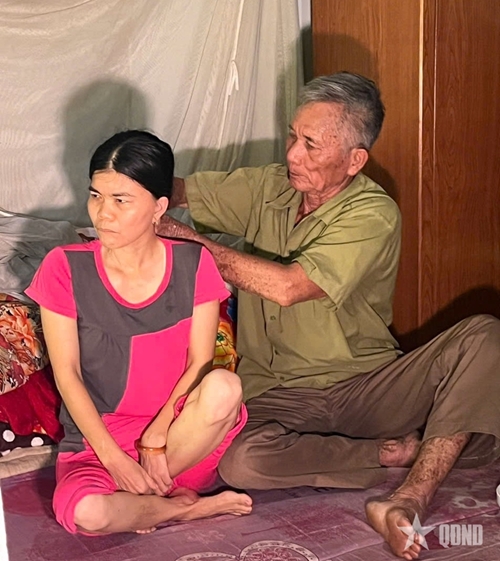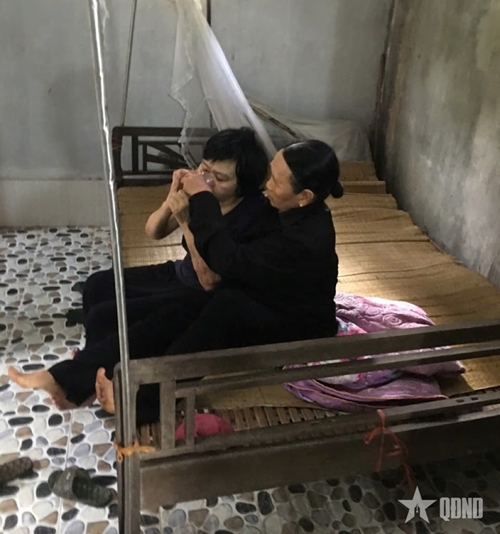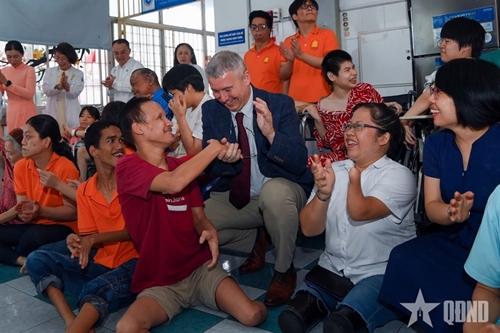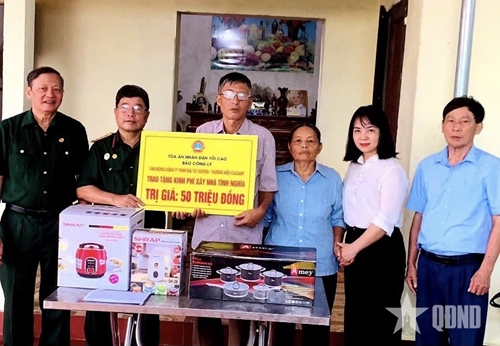On a scorching August noon, we arrived in Rieng hamlet, Dai Dong commune, Ho Binh province. Leaving our vehicle on the main road, we followed a narrow path to the house of Bui Van Kin, one of the most disadvantaged families in the commune. Six members of his household are the AO/dioxin victims.
    |
 |
|
Bui Van Kin taking care of his daughter |
At the alley entrance, his fourth child, the only one born healthy, greeted us and led us to a small backroom. There sat his second daughter, Bui Thi Huong, the most severely affected in the family. Her father, a man marked with scars from his battlefield years, gently brushed her hair away and tied it back, a tender act for a daughter nearly 50 years old.
In the sitting room, Kin shared his story. In October 1970, at 18, he joined the military and was sent to the Central Highlands Theater. He fought in fierce battles, marching through forests stripped bare of leaves, drinking from muddy streams. Once, he hid in a bomb crater to escape enemy fire. Afterward, malaria and festering sores plagued him until his discharge.
    |
 |
|
Gifts presented to AO victims |
He married in 1975 and had five children. They lived in an 18-square-meter thatched house. His second and third daughters were sickly from birth, with skin ulcers like his own. The second daughter could barely walk and often had to lie down. He took them to hospitals across the country, but no cause was found until 1995, when doctors confirmed he had been exposed to AO/dioxin. Not only his daughters, but three of his grandchildren also suffered from its effects.
Agent Orange has exposed 4.8 million Vietnamese, over 3 million of whom are victims. The chemical has caused tragedies spanning generations; hundreds of thousands have died, and many more live with serious illnesses.
In June 2021, we visited the family of Pham Thi Nu in Cay Canh hamlet, Quyet Thang commune, Thai Nguyen province (now Quyet Thang ward, Thai Nguyen province). Her home was poor and bare. She was caring for her nearly 50-year-old daughter, Ha Thi Tuyet Mai, who “will never grow up.”
    |
 |
|
Pham Thi Nu and her daughter |
Mai is completely unaware of her surroundings, unable to control her body or daily activities. Without constant supervision, she can harm herself. Once she threw herself into a fire. Another time she wandered all night after the door was left unlocked. Her condition, caused by her father’s exposure to AO/dioxin, has worsened over the years. Sometimes she attacks those who approach, forcing her mother to keep her in a separate room.
Nu recalled that in 1974, she met Ha Quang Vinh, a demobilized soldier, and they married simply, with neighbors’ blessings. Vinh told her of years fighting in Quang Tri, Laos, and Southern Vietnam, marching through defoliated forests and drinking from streams with the smell of overripe guava, a sign of chemical contamination.
A year later, they welcomed a healthy baby girl. But within months, Nu noticed strange symptoms, such as clenched jaws and vacant stares. Two years later, she gave birth to twin daughters, both died young. In 1981, she had a son, Ha Van Quang, who grew up slow to learn. Now married, his poor health leaves him dependent on his wife, and his two children also suffer from AO-related illnesses.
Research has shown that AO/dioxin can damage almost every system of the human body, causing cancer, liver and thyroid disorders, diabetes, and genetic mutations that lead to birth defects. Victims’ children and grandchildren often suffer from paralysis, blindness, deafness, intellectual disabilities, mental illness, and deformities.
    |
 |
|
Belgian Ambassador to Vietnam Karl Van Den Bossche visiting AO victims |
These are just two of many stories across Vietnam. Between 1961 and 1971, the U.S. military sprayed about 80 million liters of chemicals, 61% of which were AO, over 3.06 million hectares in Southern Vietnam, 17 times the allowable density in U.S. agriculture. Most areas were sprayed multiple times, some more than ten times.
Fifty years later, the war’s toxic legacy still endures. Many veterans who fought in contaminated areas remain at risk, and some have become advocates for victims.
Professor and Doctor of Medicine Phan Thị Phi Phi, former head of the Department of Pathophysiology–Immunology at Hanoi Medical University, served six years in Military Region 5 and is herself a victim. After the war, she could no longer have children. Her four pregnancies ended in miscarriage due to exposure.
The effects of AO have been recorded in the fourth generation in Vietnam. Estimates count around 75,000 second-generation victims and 35,000 in the third generation, with evidence of transmission to the fourth.
    |
 |
|
Leaders of the Association for AO/dioxin Victims of Bac Ninh province and sponsors hand over funding for the construction of houses for AO victims in Chu ward. |
As both doctor and victim, Dr. Phi Phi has dedicated her life to caring for others. She was among the first three Vietnamese victims to file a lawsuit in the United States. Traveling across the country, she has met families where all four children suffer from cerebral palsy, or parents who cry in fear of what will happen to their children after they are gone.
“Most AO victims are poor,” she said. “The cost of care and treatment far exceeds what they can afford. They are the poorest of the poor, the most unfortunate among the unfortunate,” said Dr. Phi Phi.
By Thuy Tien – Moc Mien
Translated by Tran Hoai